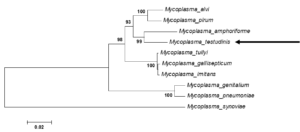Mycoplasma testudinis
(Hill, 1985)
Etymology
Gr. n. mukes – fungus, Gr. neut. n. plasma – anything formed, N.L. neut. n. Mycoplasma – fungus form; L. n. testudo – a tortoise. L. gen. n. testudinis – of a tortoise
Taxonomy
Mycoplasmatales – Mycoplasmataceae – Mycoplasma – Mycoplasma testudinis (Pneumoniae cluster), related to Mycoplasma amphoriforme (16S rRNA gene sequence similarity – 95.37%) (Fig. 1)
Type strain
01008T (Greek tortoise – Testudo graeca, UK, ≤1985), (Fig. 2, 16S rRNA gene sequence)
Genomes
one draft genome (01008T – UK) (NCBI Genome deposit per 11/05/2024)
Cell morphology
spherical – coccoid – flask-shaped
Colony morphology
fried egg morphology
Metabolism
fermentation of glucose; non-arginine-hydrolyzing, non-urea-hydrolyzing
Host
Greek tortoise (Testudo graeca)
Habitat
cloaca
Disease(s)
unknown, no disease reported
Pathogenicity
factors unknown
Epidemiology
unknown, once isolated from a pet tortoise in the UK
Diagnosis
cultivation and species identification by MALDI-ToF MS, serology or genetically
Fig. 1. Maximum likelihood tree showing the phylogenetic position of Mycoplasma testudinis 01008T within the Pneumoniae cluster of Mycoplasmataceae based on 16S rRNA gene sequences. The sequence of Mycoplasma synoviae WVU 1853T was used as out-group (Synoviae cluster). Numbers at nodes represent bootstrap confidence values (1000 replications). Only values > 80% are shown. Bar, number of substitutions per nucleotide position. Credits: Joachim Spergser (Vetmeduni Vienna)

